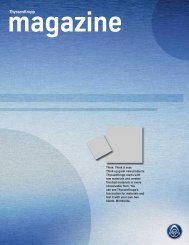Engineering
Engineering
Engineering
Create successful ePaper yourself
Turn your PDF publications into a flip-book with our unique Google optimized e-Paper software.
3.6 Consolidated financial statements Notes to the consolidated financial statements<br />
Derivatives that qualify for hedge accounting<br />
Hedge accounting in accordance with IAS 39 is used to hedge foreign<br />
currency risks of firm commitments, future receivables and liabilities<br />
denominated in foreign currency, commodity price risks arising from<br />
sales and purchase transactions, and interest rate risks from noncurrent<br />
financings.<br />
Cash flow hedges<br />
Cash flow hedges are mainly used to hedge future cash flows against<br />
foreign currency and commodity price risks arising from future sales<br />
and purchase transactions as well as interest rate risks from noncurrent<br />
liabilities. These derivatives are measured at fair value, divided<br />
into an effective and ineffective portion. Until realization of the hedged<br />
underlying transaction, the effective portion of fluctuations in fair value<br />
of these derivatives is recognized directly in equity in the cumulative<br />
other comprehensive income position, while the ineffective portion is<br />
recognized in profit or loss. The cumulative gain or loss recognized in<br />
equity is reclassified to profit or loss in the same period during which<br />
the future underlying transactions (hedged items) affect profit or loss.<br />
As of 30 September 2011, hedging instruments with positive fair value<br />
totaled €82 million (2010: €150 million) and those with negative fair<br />
value totaled €96 million (2010: €66 million). For the 2010/2011 fiscal<br />
year, €1 million (2009/2010: €97 million) (before tax) in unrealized<br />
gains or losses have been recognized directly in equity in the<br />
cumulative other comprehensive income position. Cash flows from<br />
future transactions are currently hedged for a maximum of 60 months.<br />
During the current fiscal year, €(2) million (2010: €(6) million) of<br />
cumulative other comprehensive income were reclassified to sales in<br />
profit or loss as a result of the underlying transactions being realized<br />
during the year. €(0.4) million (2010: 0) thereof are included in<br />
discontinued operations. In addition, €74 million (2010: €102 million),<br />
thereof €4 million (2010: €2 million) in discontinued operations, of<br />
cumulative other comprehensive income were reclassified to decrease<br />
cost of inventories, as the hedged commodities were recognized,<br />
although the underlying transaction had not yet been taken to profit or<br />
loss. This resulted in decreased expenses of €93 million, thereof €5<br />
million in discontinued operations, in 2010/2011 an expense of €19<br />
million, thereof €1 million in discontinued operations, of that<br />
reclassified amount is expected to impact earnings in the subsequent<br />
fiscal year. Furthermore, €5 million (2010: €121 million) of cumulative<br />
Consolidated financial statements<br />
180 | 181<br />
other comprehensive income were reclassified and decreased (2010:<br />
increased) cost of property, plant and equipment. Thereof expenses of<br />
€0.2 million impacted earnings in 2010/2011. In addition, €0.2 million<br />
of that reclassified amount is expected to impact earnings in<br />
2011/2012, €4.4 million in subsequent fiscal years.<br />
As of September 30, 2011, net income from the ineffective portions of<br />
derivatives classified as cash flow hedges totaled €(23) million<br />
(2009/2010: €11 million).<br />
The cancellation of cash flow hedges during the current fiscal year<br />
resulted in earnings of 0 (2009/2010: €(4) million) due to<br />
reclassification from cumulative other comprehensive income. These<br />
fluctuations in fair value of derivatives originally recognized in equity<br />
were reclassified to profit or loss when the hedged underlying<br />
transaction was no longer probable to occur.<br />
In the subsequent fiscal year fluctuations in fair value of derivatives<br />
included in cumulative other comprehensive income as of the reporting<br />
date is expected to impact earnings by income of €72 million. During<br />
the 2012/2013 fiscal year, earnings are expected to be impacted by<br />
income of €2 million, during the 2013/2014 fiscal year by expenses of<br />
€8 million and during the following fiscal years by expenses of €50<br />
million.<br />
Fair value hedges<br />
Fair value hedges are mainly used to hedge the exposure to changes in<br />
fair value of a firm commitment and exposure to inventory price risks<br />
as well as to hedge interest rate risks. These commodity and interest<br />
rate derivatives are measured at fair value. The carrying amounts of<br />
the corresponding underlying transactions are adjusted for the change<br />
of the fair values of the hedged risks. As of September 30, 2011,<br />
hedging instruments with positive fair value totalled 0 (2010: €4<br />
million) and those with negative fair value totalled 0 (2010: €1 million).<br />
Fluctuations in fair value are recognized immediately in profit or loss<br />
under sales, cost of sales or financial income/(expense), net,<br />
depending on the type of underlying transaction. During the fiscal year,<br />
income/(expense), net from the measurement of fair value hedging<br />
instruments totalled €1 million (2009/2010: 0), while<br />
income/(expense), net from the corresponding underlying transactions<br />
during the same period amounted to €(1) million (2009/2010: 0).

















